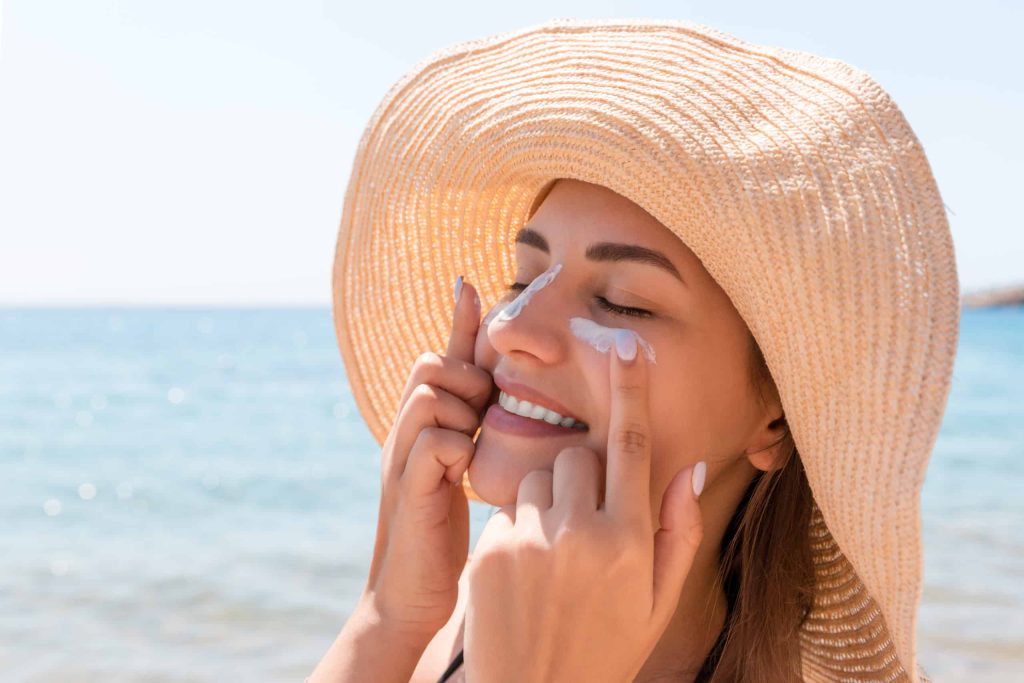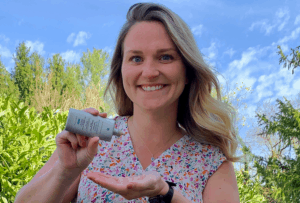
According to the Center for Disease Control (CDC), skin cancer is the most common cancer in the United States. In addition to increasing your risk of cancer, sun exposure is the leading cause of aging skin. Thankfully, skin cancer is the most preventable cancer and photoaging can easily be slowed by following NOVA Plastic Surgery and Dermatology’s sun protection recommendations.
The best line of defense against skin cancer and premature aging is properly using a daily sunscreen. But what sunscreen should you use and how should you use it? NOVA Plastic Surgery and Dermatology has answered some of the most common questions to help protect your skin and get you best prepared for the scorching Loudoun County summer around the corner.
Who should use sunscreen?
Everyone should use sunscreen! The people with the fairest skin have the most risk of burning and so they need to be the most careful, but even people with very dark skin who never get burned can still benefit from sunscreen because it will protect your skin from the damaging UVA that causes wrinkles and aging.
What type of sunscreen should I use?
You need a broad-spectrum sunscreen that blocks both UVA and UVB rays. In order to get enough blockage of both types, you need at least an SPF 30. The higher numbers do protect a little more. Some evidence shows that anything over SPF 50 may not really protect much more than a 50, but some studies show it does- it just matters how you apply it. There are two main types of sunscreen, physical barriers and chemical barriers. Both function to protect your skin, but which is best for you?
Chemical sunscreens contain active ingredients including octyl methoxycinnamate (OMC) and oxybenzone, which absorb UV rays and transform them into heat that is released from the skin. Research shows, many chemicals used in chemical sunscreens can affect your endocrine system, disrupt hormones, irritate your skin, and increase the production of free radicals. Chemical sunscreens are not effective immediately and must be applied at least 20 minutes before sun exposure. The ingredients also degrade in sunlight, so it is important to reapply these sunscreens more frequently. Chemical sunscreens may be more likely to clog pores leading to breakouts for those with oily skin and may increase skin redness, especially for those struggling with rosacea and similar skin conditions due to the chemical reaction producing heat. Since these sunscreens are absorbed into your skin, people with allergies to certain chemicals or those with sensitive skin can often get irritation from the chemical blockers.
Physical sunscreens contain mineral ingredients, zinc oxide and/or titanium dioxide, that physically block the sun’s rays from penetrating your skin. They do not absorb into the skin and sit on the surface. Mineral ingredients are less likely to cause adverse skin reactions and clog pores, so they may be a better option for those with sensitive or acne-prone skin. As opposed to producing and releasing heat from the skin, they reflect heat and are a healthier option for those with rosacea or other conditions involving skin redness. Have you ever put sunscreen on at the beach and felt your skin light on fire? No need to worry about that with a physical sun blocker!
While both physical and chemical sunscreens can be effective for blocking the sun’s UV rays, physical sunscreens offer broad-spectrum coverage without the negative effects of chemical sunscreens. We recommend SkinCeuticals Physical Fusion UV Defense SPF 50. This high protection physical sunscreen is an effective broad-spectrum UVA/UVB protection without feeling too heavy on the skin.
Where should I apply sunscreen?
Everyday just going to work, school or the grocery store you should apply sunscreen to your face, neck, chest and hands/arms- the places that aren’t covered by your clothes. When you are going swimming, to the beach or running a marathon in those tiny singlets that are almost like bathing suits, then apply to your full body in your house before you leave.
When should I apply sunscreen?
All day!! Every day!! Even on cloudy days UVA and UVB still make it down to us. So, once again, even if you are not going to get a sunburn, that nasty UVA can still make you look older! Now, you do not have to wear it at night, but during the daylight, you should use it. You should be applying every 2 hours because it wears off as you move around and sweat and swim. L’Oreal makes a nice spray sunscreen that you can apply to wet skin- great for when you are chasing your kids around during the “adult swim” break at the pool and they won’t towel off first. Reapplying is also good in case you missed a spot the first round. So instead of that spot being ignored for 8 hours at the beach, maybe it was only the first 2 hours that got the full force of the sun?
Your first application of sunscreen should be about 30 minutes before you leave the house. That is how long it takes for sunscreen to sink into your skin and really be effective. So, if you wait until you are at the beach and then apply it, don’t be surprised if you still get some burning. Even if you still remembered to reapply often- you didn’t get the full benefit by starting out with it on at home. If you’re worried about getting enough Vitamin D because you are so protected from the sun, The American Academy of Dermatology says that it is much better to get your Vitamin D from a multivitamin. It isn’t worth risking cancer to get it from the sun.
Why do we need sunscreen?
We need to protect our skin from the sun’s harmful ultraviolet rays. The two types of ultraviolet radiation that we care about when talking about sunscreen are Ultraviolet A (UVA) and Ultraviolet B (UVB). UVA causes Aging, like brown sunspots and wrinkles. UVB causes Burning, so those blistering sunburns you got as a kid when you missed a spot and you stayed out too long. UVA rays can penetrate through windows, so when you are on long car rides, or if you are sitting at work next to a window, you still need to worry about UVA damage, even if you won’t get a sunburn because the UVB is blocked by glass. Have you ever noticed you have more freckles on your left side or that the skin tends to sag a little bit more? It’s from UV exposure through the car window when driving. If you get enough exposure of either type of UV rays, you can get skin cancers.
Do you need sunscreen if you are working from home and are not near any windows? Yes. Unfortunately, high-energy visible (HEV) light also referred to as blue light emitted by your smartphone, tablet and computer screen are destructive against your skin as well. This light has been associated with increased signs of photoaging such as fine lines and wrinkles, skin laxity, and dark spots. The startling difference is that blue light can penetrate deeper into the skin than UVA light causing deeper signs of aging. Therefore, the negative effects of sun exposure do not disappear when the sun goes down.
How should I apply sunscreen?
When you need to apply full body sunscreen: get naked. Put it everywhere, wait a few minutes to dry, then put your suit on. This way you are less likely to forget to do the tops of your feet or under a weird bathing suit strap that will probably slip around and give you weird tan lines.
You also need to consider sun-protective clothing and sun avoidance! A plain white T-shirt has about a protection factor of 4, so it really isn’t helping you out much. There are a lot of companies out there that make very cute protective hats and clothing that have a protection factor of 50 and higher. You can also buy laundry detergent that adds UPF to your clothes, but it is expensive, and you must keep using it to keep up the UPF factor. Sun avoidance is also very important. Especially if you already have a history of Melanoma or other skin cancers, you really need to try to stay out of the sun during its strongest hours. That is usually from 9 am to 4 pm. It isn’t enough to just stay in the shade. Since the sun’s harmful rays reflect off surfaces such as water, snow, and buildings, you still must wear both sunscreen and sun-protective clothing.
How does sunscreen prevent aging?
The right SPF is the most important anti-aging product. Sun exposure is responsible for 90 percent of visible changes to the skin, including fine lines and wrinkles, dark spots, decreased elasticity and change in overall tone and texture. Photoaging is premature aging of the skin as a result of cumulative UV exposure, primarily from sunlight but also artificial sources including light from your electronics. Over time, the sun’s UV rays damage fibers in the skin called elastin. When there is less healthy elastin in the skin, the skin starts to droop, stretch, and lose its elasticity to go back into place after stretching. This leads to sagging skin and deep wrinkles over time. With less elastin, skin also bruises and tears more easily prolonging normal healing time. Although we do not see the effects of sun damage when we are young, I can guarantee you it will show later in life and a daily sunscreen now is your best protection against later. Adding a morning Vitamin C antioxidant will assist in sun protection and help fight off environmental free radicals, which also contribute to photoaging.
Is SPF in my makeup or moisturizer enough?
We are happy you understand it is important to include SPF in your daily regimen but SPF in your makeup is not enough to achieve full benefits and protection. We do not use nearly enough foundation or moisturizer to reach an adequate barrier to the sun. However, products including SPF provide additional protection from the sun’s harmful rays and are a great addition to your physical sunscreen. Sunscreen should be the final step in your daily care regimen after using any corrective serums, creams or moisturizers. After applying sunscreen to your face, neck, and chest, your skin is prepped and good to go for your typical makeup routine.
In conclusion
Your best protection is a daily broad-spectrum tinted physical sunscreen rich in antioxidants. Iron oxide spheres in tinted sunscreen act to enhance natural skin tone and boost radiance while providing a universal tint. Research suggests that iron oxides found in tinted sunscreen offer significant protection against blue light sensitivity in addition to UVA/UVB protection when compared to a control sunscreen. Additionally, antioxidants help fight reactive oxygen species and minimize the chain reaction of damage before it visibly impacts your skin.
Most importantly, apply sunscreen every day, year-round, in every type of weather if you plan to go outside or not. If you are looking for more specific sunscreen recommendations based on your skin type, or if you have a history of skin cancer and need a full-body skin check, then book a dermatology appointment now at NOVA Plastic Surgery and Dermatology in Ashburn, VA.
What else can I do?
Use a daily Vitamin C serum such as SkinCeuticals C E Ferulic, SkinCeuticals Phloretin CF, or SkinCeuticals Serum 10 to neutralize free radicals induced by UVA/UVB rays, infrared radiation and ozone pollution. Schedule your total body full skin exam with our Dermatology Physician Assistant, Morgan Klein. Morgan is trained to identify suspicious moles and lesions, evaluate signs of sun damage and detect skin cancer.
